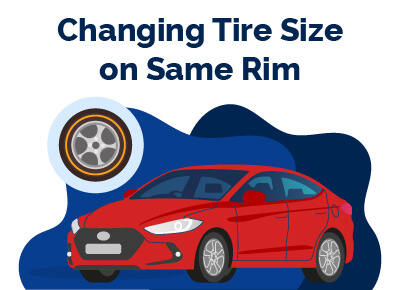Changing Tire Size on Same Rim (All You Need To Know!)
May 30, 2023


Chris is Head of Content for FindTheBestCarPrice and is based out of Philadelphia, PA. As a seasoned automotive industry analyst and car enthusiast, he ensures the highest level of quality across all our content and curates our picks for the best deals each month.
Chris studied information systems and marketing at Drexel University and writes about a wide range of topics ranging from car buying tips to troubleshooting common mechanical issues.
When he’s not thinking about cars, he likes to stay in with his dog and make an “attempt” to finish a crossword puzzle (he’s not quite at the Saturday/Sunday level…yet). As a former cheesemonger, Chris still has a “sharp” passion for all things cheese, and his fridge is always loaded with it!
Chris also has a passion for things that go fast, and drones are no exception. He spends some of his time writing for Dronesourced.
A lot of questions should be running through your mind as you're trying to change the tires of your car. Do I have to replace the tires with the same size? What happens if I put the wrong tire size on a rim? Can I change tire sizes on the same rim?
It's even possible that you aren't sure of your Rim width, making it impossible to know the accurate tire size for replacement.
Well, when it comes to changing the tire size on the same rim, you can use different tire sizes on the same rim. This is highly inadvisable, but changing the tire sizes on the same rim is possible as long as you maintain the same internal diameter and ensure that the tire sizes fall within the specified width range.
But is it bad to have one tire bigger than the other? Read on to find out all you need to know about changing the tire size on the same rim.
Table of Contents
Can You Change the Tire Size on the Same Rim?
Yes. You can. Most times, the fundamental area of tire fittings lies in the wheel size. This implies that irrespective of the sizes of the tires, as long as the middle fits the wheels, you're good to go.
What this means is that any 18-inch tire can easily fit an 18-inch rim. You can also use different tire sizes on the same rim as long as they are within the rim range of the car.
However, there's a twist in this narrative. While it is possible that you can change tire sizes on the same rim, you must understand that there's a high chance that your car will be thrown out of balance, and this can pose a big risk to your safety.
The truth is that the compatibility of tires goes beyond their rim width. There are different tires for different terrains and driving conditions.
When you mix different tires of different diameters and widths, you'll have issues with traction, steering angle, increased side wear, and even braking problems.
More importantly, it will impact the aspect ratio, influence the speedometer, and have you piling up more mileage than your actual speed.
Sometimes, the risk extends to having constant tire rubs on the chain, which can cause the chain to slip, a very dangerous situation when you are running at high speeds.
We do not recommend changing tire sizes on the same rim to prevent compromising the spacing between your tires and the chain, the balance of your car, or even affecting your suspension components and brake systems.
However, if, for any reason, you wish to use tires of different widths on the same rim, there are a few factors that you must consider.
Changing Tire Size on Same Rim: What To Consider
There are a lot of factors that you must consider when changing the tire size on the same rim. These factors will help you decide if the tire sizes fit your rim and if they will pose any risk to driving performance.
Here are four common factors to consider when changing the tire size on the same rim.
1. Inner Diameter
One of the most crucial factors you must consider when changing tires on the same rim is its internal diameter.
The tire's inner diameter, wheel diameter, or rim diameter, whichever name it bears, relates to the internal size of the tire. This acts as a good determinant to decide if the tire will fit the wheel.
When you decide to change tire size on the same rim, it's important that you confirm that the wheel and tire size are both compatible. If not, the tire will rub on the wheel, which will impact friction and cause a build-up of heat, which can lead to a blowout.
There isn't much issue if you decide to use taller or bigger tires (in relation to the distance from the outside of the tires). However, you must consider the ratio between the rim width and tire width. This is because some rims might not be able to contain the tires when they are properly inflated.
2. Tire Size
The tire size that you wish to fit on the same rims is another factor that you must consider. However, for you to be able to do this, you must know how to read tire sizes properly.
Every tire size offers readings in three dimensions:
- Tire width
- Thread height
- Rim diameter
A tire with the inscription of 235/45r18 means the tire width is 235 millimeters, 45% aspect ratio, and 18-inch rim diameter. The R stands for radial structure. Some older tires come with diagonal bias (D) or bias belted (B) construction structures.
Sometimes, it's normal to switch the tire width of your tires, swapping thin tires for bigger ones, as long as they have the same wheel rim diameter.
While this offers improved vehicle handling and a great advantage during winter seasons, you must understand that it is not advisable to mix tires on different wheels. Don't attempt to have different tire sizes on the front and rear wheels of your car.
3. Wheel Well
Wheel well refers to the space between the body of your car and the wheels. The wheel well works with the offset to determine the amount of space allocated to enable the wheels to achieve proper turns and rotations.
This ensures that the wheel and tires are aligned at the center to avoid the tires making contact with the fenders, suspension, frame, or even shock absorbers.
Sometimes, you might choose a tire that is in line with the rim diameter but too tall that they make contact with the wheel well. So it's important that you consider the height of the tires, just as you are confirming their inner diameter.
4. Rim Width Range
Every car has a rim width range that determines the wheel size that the car can accommodate. The rim width range offers slight adjustments to accommodate smaller or bigger wheel sizes.
The standard rule for rim width range adjustments is that for a half-inch increase in the rim width, the tire's section width should accommodate an approximately 2/10-inch increase.
For instance, a 235/45r18 tire has a sectional width of 9.3 inches and a rim width range of 7.5 to 9.0 inches.
It's important that you confirm the rim width range, comparing it with the sectional width of the tire to decide they are the perfect match for your rim.
Can You Put a Different Tire Size on the Same Rim?
Yes, you can. You can put different tire sizes on the same rim as long as you ensure that the inner diameter matches the rims of the wheels.
This means that no matter how big or small the tires are, your primary focus should lie on ensuring that the inner diameter of the tire matches that of the tires.
Conclusion
You're free to change tire sizes on the same rim, but you must be fully aware of the risks of doing so. Different tire sizes impact the performance of your car and the overall durability of your car components.
It is important to mention that changing tires will not void your car's warranty, except if the company confirms that the cause of damage was due to misuse of tire sizes.
Best Car Deals by Category
Frequently Asked Questions
How much difference in tire size is acceptable?
The acceptable difference in tire size is 3% from your previous tire diameter. The 3% diameter increase applies to the height difference, and this is applicable if your old tires maintain sizing according to the manufacturer's specifications.
Can the wrong-sized tires damage cars?
Yes. The wrong-sized tires will not only damage your car but also pose great risks to your safety. Wrong-sized tires can rub on your fenders, and prolonged use can damage your suspension, brakes, or wheel well.
Does changing tire size affect speed?
Yes. Changing tire size will not only affect your speed but will also affect your speedometer readings. The average speed of your car is impacted by the circumference and number of rotations the tire has. Larger tires have fewer rotations, and their larger wheel diameters will achieve more composed handling and better stability, but smaller tires get better acceleration.
Is it OK to have two different size tires?
No. It's not OK to have two different size tires on the same axle. We strongly advise against mixing different tires on your car. Avoid the use of tires with different tread patterns and aspect ratios; you should consider sticking to using one car tire brand.
Posted in Car Buying Tips, Car Troubleshooting |




